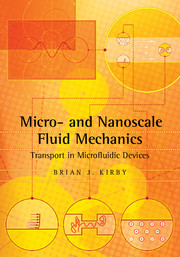Book contents
- Frontmatter
- Contents
- Preface
- Nomenclature
- Introduction
- 1 Kinematics, Conservation Equations, and Boundary Conditions for Incompressible Flow
- 2 Unidirectional Flow
- 3 Hydraulic Circuit Analysis
- 4 Passive Scalar Transport: Dispersion, Patterning, and Mixing
- 5 Electrostatics and Electrodynamics
- 6 Electroosmosis
- 7 Potential Fluid Flow
- 8 Stokes Flow
- 9 The Diffuse Structure of the Electrical Double Layer
- 10 Zeta Potential in Microchannels
- 11 Species and Charge Transport
- 12 Microchip Chemical Separations
- 13 Particle Electrophoresis
- 14 DNA Transport and Analysis
- 15 Nanofluidics: Fluid and Current Flow in Molecular-Scale and Thick-EDL Systems
- 16 AC Electrokinetics and the Dynamics of Diffuse Charge
- 17 Particle and Droplet Actuation: Dielectrophoresis, Magnetophoresis, and Digital Microfluidics
- APPENDIX A Units and Fundamental Constants
- APPENDIX B Properties of Electrolyte Solutions
- APPENDIX C Coordinate Systems and Vector Calculus
- APPENDIX D Governing Equation Reference
- APPENDIX E Nondimensionalization and Characteristic Parameters
- APPENDIX F Multipolar Solutions to the Laplace and Stokes Equations
- APPENDIX G Complex Functions
- APPENDIX H Interaction Potentials: Atomistic Modeling of Solvents and Solutes
- Bibliography
- Index
4 - Passive Scalar Transport: Dispersion, Patterning, and Mixing
Published online by Cambridge University Press: 05 June 2012
- Frontmatter
- Contents
- Preface
- Nomenclature
- Introduction
- 1 Kinematics, Conservation Equations, and Boundary Conditions for Incompressible Flow
- 2 Unidirectional Flow
- 3 Hydraulic Circuit Analysis
- 4 Passive Scalar Transport: Dispersion, Patterning, and Mixing
- 5 Electrostatics and Electrodynamics
- 6 Electroosmosis
- 7 Potential Fluid Flow
- 8 Stokes Flow
- 9 The Diffuse Structure of the Electrical Double Layer
- 10 Zeta Potential in Microchannels
- 11 Species and Charge Transport
- 12 Microchip Chemical Separations
- 13 Particle Electrophoresis
- 14 DNA Transport and Analysis
- 15 Nanofluidics: Fluid and Current Flow in Molecular-Scale and Thick-EDL Systems
- 16 AC Electrokinetics and the Dynamics of Diffuse Charge
- 17 Particle and Droplet Actuation: Dielectrophoresis, Magnetophoresis, and Digital Microfluidics
- APPENDIX A Units and Fundamental Constants
- APPENDIX B Properties of Electrolyte Solutions
- APPENDIX C Coordinate Systems and Vector Calculus
- APPENDIX D Governing Equation Reference
- APPENDIX E Nondimensionalization and Characteristic Parameters
- APPENDIX F Multipolar Solutions to the Laplace and Stokes Equations
- APPENDIX G Complex Functions
- APPENDIX H Interaction Potentials: Atomistic Modeling of Solvents and Solutes
- Bibliography
- Index
Summary
Many microfluidic systems are used to manipulate the distribution of chemical species. Chemical separations, for example, physically separate components of a multispecies mixture so that the quantities of each component can be analyzed or so that useful species can be concentrated or purified from a mixture. Many biochemical assays, for example DNA microarrays, require that a reagent be brought into contact with the entirety of a functionalized surface, i.e., that the reagents in the system be well mixed. Studies of homogeneous kinetics in solution require that a system become well mixed on a time scale faster than the kinetics of the reaction. In contrast to these, extracting functionality from a spatial variation of surface chemistry often depends on the ability to pattern surface chemistry with flow techniques, which requires that components of the solution remain unmixed.
These topics all motivate discussion of the passive scalar transport equation. This convection–diffusion equation governs the transport of any conserved property that is carried along with a fluid flow, moves with the fluid, and does not affect that fluid flow. Chemical species and temperature are two examples of properties that can be handled in this way, as long as (1) the chemical concentration or temperature variations are low enough that transport properties such as density or viscosity can safely be assumed uniform, and (2) we neglect electric fields, which can cause migration of chemical species relative to the fluid.
- Type
- Chapter
- Information
- Micro- and Nanoscale Fluid MechanicsTransport in Microfluidic Devices, pp. 79 - 96Publisher: Cambridge University PressPrint publication year: 2010
- 1
- Cited by



